Development of Dynamic Problem-Solving Teaching Method in High School Physics Learning
Abstract
Keywords
Full Text:
PDFReferences
Ansari, B., & Abdullah , R. (2020). Higher order thinking skill (hots) bagi kaum milenial melalui inovasi pembelajaran matematika. Malang: CV IRDH.
Bao, L., & Koenig, K. (2019). Physics education research for 21st century learning. Disciplinary and Interdisciplinary Science Education Research, 1(1), 2.
Boham, M. W., & Domu, I. (2021). Penerapan Model Discovery Learning Untuk Meningkatkan Kemampuan Siswa Menyelesaikan Soal-Soal Matematika Berkategori HOTS. MARISEKOLA: Jurnal Matematika Riset Edukasi dan Kolaborasi, 2(1), 5-8.
Brookhart, S. M. (2010). How to assess higher-order thinking skills in your classroom. United States of Amerika: ASCD.
Darmaji, D., Kurniawan, D. A., & Irdianti, I. (2019). Physics education students' science process skills. International Journal of Evaluation and Research in Education, 8(2), 293-298.
Dewantara, D., Misbah, M., Haryandi, S., & Mahtari, S. (2021). Game-based learning for the mastery of HOTS in prospective physics teachers in digital electronics courses. Journal of Physics: Conference Series, 1869(1), 012153. IOP Publishing.
Funke, J., Fischer, A., & Holt, D. V. (2018). Competencies for complexity: Problem solving in the twenty-first century. Assessment and teaching of 21st century skills: Research and applications, 41-53.
https://doi.org/10.1007/978-3-319-65368-6_3.
Funke, J., & Greiff, S. (2017). Dynamic problem solving: Multiple-item testing based on minimally complex systems. Competence assessment in education: Research, models and instruments, 427-443.
https://doi.org/10.1007/978-3-319-50030-0_25.
Greiff, S., Wüstenberg, S., & Funke, J. (2012). Dynamic problem solving: A new assessment perspective. Applied Psychological Measurement, 36(3), 189–213.
Haris, A., Muris, M., & Herman, H. (2016). Penerapan strategi dynamic problem solving untuk menumbuhkan keterampilan proses sains mahasiswa. Jurnal Penelitian Pendidikan INSANI, 19(2), 65.
Hidayati, H., & Ramli, R. (2018, April). The implementation of physics problem solving strategy combined with concept map in general physics course. IOP Conference Series: Materials Science and Engineering, 335(1), 012077. IOP Publishing.
Hodosyova, M., Útla, J., Vnukova, P., & Lapitkova, V. (2015). The development of science process skills in physics education. Procedia-Social and Behavioral Sciences, 186, 982-989.
Ince, E. (2018). An overview of problem solving studies in physics education. Journal of Education and Learning, 7(4), 191-200.
Lopez-Jimenez, P. A., Gil-Duque, G. M., & Garces-Gómez, Y. A. (2021). Real problem solving as a teaching strategy for physics education: Case study. Jurnal Pendidikan IPA Indonesia, 10(1), 15-23.
Karmila. (2016). Pengaruh model pembelajaran small group discussion terhadap hasil belajar matematika siswa kelas 8 SMP Negeri 1 Palakka Kabupaten Bone. Watampone: STKIP Muhammadiyah Bone.
Kemendikbudristek. (2019). Higher order thingking skills bekal bersaing di abad 21. Jakarta: Direktorat Jendral Guru dan Tenaga Kependidikan.
Knapp, L., & Glenn, A. (1996). Restructuring schools with technology. Massachusettes: Ally & Bacon.
Limbach, B., & Waugh, W. (2010). Developing Higher Level Thinking. Journal of instructional pedagogies, 3.
Mertens, D. M. (2023). Research and evaluation in education and psychology: Integrating diversity with quantitative, qualitative, and mixed methods. Sage publications.
Ministry of Education. (2013). Inisiatif kemahiran berfikir aras tingggi di sekolah. Malaysia: MOE.
Nirmalakhandan, N. (2013). Improving problem-solving skills of undergraduates through computerized dynamic assessment. Procedia-Social and Behavioral Sciences, 83, 615-621.
https://doi.org/10.1016/j.sbspro.2013.06.117.
Reed, S. K., & Vallacher, R. R. (2020). A comparison of information processing and dynamical systems perspectives on problem solving. Thinking & Reasoning, 26(2), 254-290.
https://doi.org/10.1080/13546783.2019.1605930.
Schulz, H. W., & FitzPatrick, B. (2016). Teachers’ understandings of critical and higher order thinking and what this means for their teaching and assessments. Alberta Journal of Educational Research, 62(1), 61-86.
Resing, W. C., Bakker, M., Pronk, C. M., & Elliott, J. G. (2016). Dynamic testing and transfer: An examination of children's problem-solving strategies. Learning and Individual Differences, 49, 110-119.
Simanullang, N. S. (2021). Fisika dalam kehidupan. Indonesia: Guepedia.
Stevenson, C. E., Heiser, W. J., & Resing, W. C. M. (2016). Dynamic testing of analogical reasoning in 5- to 6-year-olds: multiple-choice versus constructed-response training items. Journal of Psychoeducational Assessment, 34(6), 550–565. https://doi.org/10.1177/0734282915622912.
Wüstenberg, S., Stadler, M., Hautamäki, J., & Greiff, S. (2014). The role of strategy knowledge for the application of strategies in complex problem solving tasks. Technology, Knowledge and Learning, 19, 127-146.
https://doi.org/10.1007/s10758-014-9222-8.
Yani, M., Mastuang, M., & Misbah, M. (2021). Development of solid elasticity modules with guided inquiry model to train critical thinking skills. Kasuari: Physics Education Journal (KPEJ), 4(1), 44-56.
DOI: https://doi.org/10.20527/jipf.v8i2.11137
Refbacks
- There are currently no refbacks.
Indexed by: Jurnal Ilmiah Pendidikan Fisika is licensed under a creative commons attribution-share alike 4.0 international license
Statistics Counter |

















